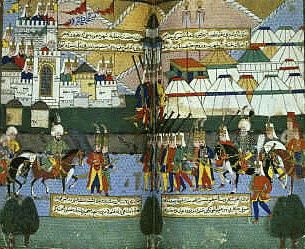Kelvyquayo
Chieftain
- Joined
- Sep 13, 2007
- Messages
- 68
1177AD
Road to Revolution VII
REVOLUTION!

The People's Revolution was a movement that began with Martim Samuel's activities in 1177 and ended with a full representative government in 1218. The movement began as an attempt to reform the Judaic priesthood and led to the fracturing of Judaism. Many eastern Jews were troubled by what they saw as false doctrines and malpractices within the Palace, particularly involving the teaching and sale of indulgences. Another major contention was the practice of buying and selling priest positions and the tremendous corruption found at the time within the Palace's hierarchy. This corruption was systemic at the time, even reaching the position of the Great Teacher.
In Fall of 1177, in Lisbon (in what is now Iesolonon), Martim Samuel nailed his Eighty-Seven Theses On the Power of Indulgences to the door of the Hagia Sophia, which served as a pin board for university-related announcements. These were points for debate that criticized the Palace and the Teacher. The most controversial points centered on the practice of selling indulgences and the Palace's policy on slavery which had always been points of contentions amongst international councils. The way had therefore been long prepared for a rebellious group within the Palace to withdraw their allegiance from the divinely established authority of the Great Teacher and to attempt to remodel the Palace according to their desires. All that was needed was a pretext and that pretext was found in the widespread need for reform evident in the Palace at the beginning of the tenth century.

With this separation amongst the factions of the Palace; leaders of the Samualist Armies sided with the abolitionist factions of the Buddhists and Taoist factions and the military. Simultaneously the orders were given from the Palace to send in assassination squads kill the political leaders of the rebellion. When these started to occur the people began openly attacking the Judaic Police Squads in large number throughout the cities and throughout the entire countryside, slaves along with the citizens stopped working. About one month after the revolts started, the rebel groups declared a general non-payment of taxes in explicit opposition to religious slavery and non-representation. In the countryside, armed insurrection started sporadically, becoming more organized with time. One particular target of the rebels was the holy summer home, Angkor Wat; constructed only a few years earlier. Other attacks were on on the palaces of the Chariot-lords themselves and finally on the Apostolic Palace. Armed revolt swept the streets of Anthonia as rebels fought back against attempts by the government of the Palace to impose a military clampdown on the city.

Tens of thousands of rebel Jew, Taoist, and Buddhist alike poured into the streets all throughout the Empire, ignoring the inevitable consequences of renewed confrontation with large numbers of police squads deployed in the cities. Angry mobs burnt down police living quarters, tore up roads, and also seized the fortresses of the Chariot-lords. The rebels had stripped the police barracks of their weapons and it was only a matter of time before they completely overran the Apostolic Palace and the entire Judao-Chariot-lord empire. A rising followed in the north cities and forty thousand armed men made the "Pilgrimage of Freedom" to Anthonia to protest against the robbery of the temples and synagogues. The Apostolic teacher who had now attempted to assume power during this revolution had no other choice but to concede. A number of courts were then set up in every city and the local lords and commanders of the police squads were imprisoned or executed.
The Great Teacher, however, could still not be harmed. Whatever his wrongdoings, the majority of the citizens still viewed him as a religious leader. Elections were immediately put underway. Regional leaders throughout the land sent in their votes as free citizens. The Apostolic Jews elected their new Great Teacher and the Citizens each elected their regional Representatives, who then decided the national laws and policies. A main political leader, the Prime Minister, would assume role as chief executive. This person was to be first off, chosen from the Saunders family. As the elected officials had been the old Taoist and Buddhist underground leaders, they came to prosper as the those who were naturally loved by the common folk as heroes. So as it were the direction of the wealth had now shifted from the Chariot-lords, to the old labor leaders. These men constructed a complex bureaucracy based on the varying skills of the labor force. Unfortunately the educational system still needed to be reformed and there was much displacement of peoples. The Judaic religious structure was left in place, only with the Samuelist Doctrines included into the theology. The trade laws, all foreign, and domestic policies were placed into the hands of the elected officials as well. By 1218 a complete representative government had formed where once there was a military police state.

Road to Revolution VII
REVOLUTION!

The People's Revolution was a movement that began with Martim Samuel's activities in 1177 and ended with a full representative government in 1218. The movement began as an attempt to reform the Judaic priesthood and led to the fracturing of Judaism. Many eastern Jews were troubled by what they saw as false doctrines and malpractices within the Palace, particularly involving the teaching and sale of indulgences. Another major contention was the practice of buying and selling priest positions and the tremendous corruption found at the time within the Palace's hierarchy. This corruption was systemic at the time, even reaching the position of the Great Teacher.
In Fall of 1177, in Lisbon (in what is now Iesolonon), Martim Samuel nailed his Eighty-Seven Theses On the Power of Indulgences to the door of the Hagia Sophia, which served as a pin board for university-related announcements. These were points for debate that criticized the Palace and the Teacher. The most controversial points centered on the practice of selling indulgences and the Palace's policy on slavery which had always been points of contentions amongst international councils. The way had therefore been long prepared for a rebellious group within the Palace to withdraw their allegiance from the divinely established authority of the Great Teacher and to attempt to remodel the Palace according to their desires. All that was needed was a pretext and that pretext was found in the widespread need for reform evident in the Palace at the beginning of the tenth century.

With this separation amongst the factions of the Palace; leaders of the Samualist Armies sided with the abolitionist factions of the Buddhists and Taoist factions and the military. Simultaneously the orders were given from the Palace to send in assassination squads kill the political leaders of the rebellion. When these started to occur the people began openly attacking the Judaic Police Squads in large number throughout the cities and throughout the entire countryside, slaves along with the citizens stopped working. About one month after the revolts started, the rebel groups declared a general non-payment of taxes in explicit opposition to religious slavery and non-representation. In the countryside, armed insurrection started sporadically, becoming more organized with time. One particular target of the rebels was the holy summer home, Angkor Wat; constructed only a few years earlier. Other attacks were on on the palaces of the Chariot-lords themselves and finally on the Apostolic Palace. Armed revolt swept the streets of Anthonia as rebels fought back against attempts by the government of the Palace to impose a military clampdown on the city.

Tens of thousands of rebel Jew, Taoist, and Buddhist alike poured into the streets all throughout the Empire, ignoring the inevitable consequences of renewed confrontation with large numbers of police squads deployed in the cities. Angry mobs burnt down police living quarters, tore up roads, and also seized the fortresses of the Chariot-lords. The rebels had stripped the police barracks of their weapons and it was only a matter of time before they completely overran the Apostolic Palace and the entire Judao-Chariot-lord empire. A rising followed in the north cities and forty thousand armed men made the "Pilgrimage of Freedom" to Anthonia to protest against the robbery of the temples and synagogues. The Apostolic teacher who had now attempted to assume power during this revolution had no other choice but to concede. A number of courts were then set up in every city and the local lords and commanders of the police squads were imprisoned or executed.
The Great Teacher, however, could still not be harmed. Whatever his wrongdoings, the majority of the citizens still viewed him as a religious leader. Elections were immediately put underway. Regional leaders throughout the land sent in their votes as free citizens. The Apostolic Jews elected their new Great Teacher and the Citizens each elected their regional Representatives, who then decided the national laws and policies. A main political leader, the Prime Minister, would assume role as chief executive. This person was to be first off, chosen from the Saunders family. As the elected officials had been the old Taoist and Buddhist underground leaders, they came to prosper as the those who were naturally loved by the common folk as heroes. So as it were the direction of the wealth had now shifted from the Chariot-lords, to the old labor leaders. These men constructed a complex bureaucracy based on the varying skills of the labor force. Unfortunately the educational system still needed to be reformed and there was much displacement of peoples. The Judaic religious structure was left in place, only with the Samuelist Doctrines included into the theology. The trade laws, all foreign, and domestic policies were placed into the hands of the elected officials as well. By 1218 a complete representative government had formed where once there was a military police state.























.jpg)








































